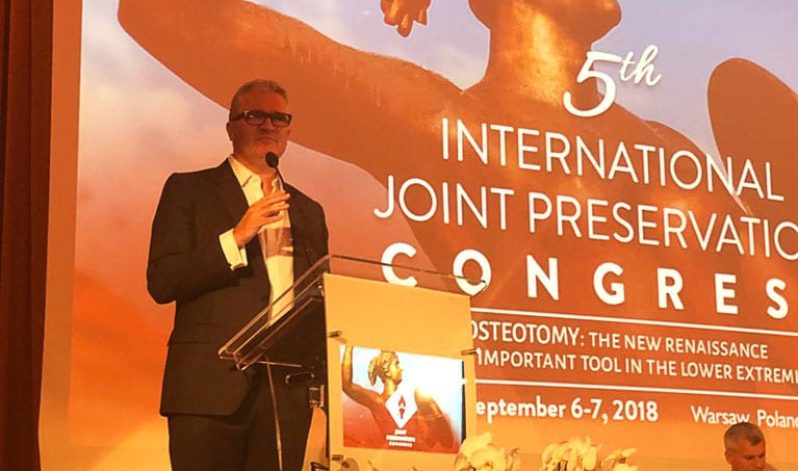MILAN, July 11, 2017 /PRNewswire/ — “Lipogems has been used in over 20,000 cases worldwide in a variety of clinical settings, including studies that have evaluated its use in orthopaedic pathologies. We commend the principle investigators at the Rizzoli Institute for bringing a high level scientific rigor to determine if patients with knee osteoarthritis have better functional outcomes and are more satisfied with Lipogems when compared to the biologic gold standard,” said Giorgio Ninzoli, CEO of Lipogems International. The physicians and researchers at the Rizzoli Institute are conducting the first prospective, randomized and controlled study comparing the safety and performance of a single intra-articular injection of micro-fragmented adipose tissue (Lipogems) versus platelet rich plasma (PRP) in patients with knee osteoarthritis. Click here to learn more about the study.118 patients will be randomly assigned to receive either Lipogems or PRP, which is the biologic gold standard of care for non-operative treatment of symptomatic knee osteoarthritis.The study will evaluate the improvement of the patient’s symptoms, functional recovery, and tissue architecture using Magnetic Resonance Imaging (MRI). The patients will be followed for two years post procedure.Patients enrolled in this study must have failed conservative treatment for at least three months and agree to actively participate in the rehabilitation and follow-up program.Lipogems under the microscope: Lipogems is minimally manipulated adipose tissue that maintains the cell and tissue microarchitecture. Inside of the concentrated cells, it contains important components including stem cells, pericytes, adipocytes, muse cells that are essential to help facilitate a healing microenvironment. (PRNewsfoto/Lipogems)The societal impact of degenerative diseases, such as articular cartilage pathology, is steadily increasing because patients are living longer and are more active. Patients with articular cartilage lesions may have joint pain and reduced function, and often progress to end-stage osteoarthritis, which is one of the top 10 causes of disability worldwide. Many non-invasive treatment options are available but may have limitations and may not improve patient’s mobility and quality of life. Orthopedic surgeons are seeking options to postpone surgery. Adipose tissue, commonly known as fat, has many natural reparative characteristics that help to promote a healing environment through the harmonious work of its various components, including mesenchymal stem cells (MSCs), pericytes, and other cell types embedded in its collagen scaffold. Indeed, through trophic, mitogenic, anti-scarring, anti-apoptotic, immunomodulatory, and anti-microbial actions, produced by a large amount of bioactive elements, growth factors and cytokines, these cells “sense” and “signal” changes in the microenvironment where they reside. The adipose tissue is rich in vascular niches that, besides providing a readily available source of native cushioning, could serve as a smart source of MSCs.“The use of adipose-derived MSCs, either culture-expanded or obtained by mechanical or enzymatic treatment as the stromal vascular fraction, have recently become the subject of intense interest in the field of orthopaedics and has shown some promising results,” said Carlo Tremolada, MD, plastic and cranomaxillofacial surgeon and founder of Lipogems, “However, the studies published to date used a tissue engineering approach, involving the use of scaffolds, cells, and growth factors, either alone or in some combination. In addition to requiring a large number of expensive and complex processing steps, there are significant regulatory restrictions associated with cell expansion and manipulation, and the results achieved to date are far from being completely satisfactory. Therefore, availability of a minimally manipulated adipose tissue for use in this setting would have enormous clinical relevance. The Lipogems technology overcomes all these issues. The procedure is simple, economic, quick, minimally invasive, one-step, safe and compliant.”Lipogems will provide the medical devices for the study and expenses for the patients (for example, insurance, MRI). However, physicians conducting the study will not be compensated for their effort.About Rizzoli Institute of OrthopedicsThe Rizzoli Orthopedic Institute is the main Italian institute of orthopedics and traumatology that has a status of ‘Scientific research hospital’ due to its high level of healthcare. To learn more about the Rizzoli Institute, please click here: http://www.ior.it/en/curarsi-al-rizzoli.About Lipogems CompanyLipogems is an innovative company whose vision is to bring responsible and effective reparative solutions to physicians and patients to help maintain or restore their lifestyle and improve their quality of life and recovery time. These solutions may offer an alternative for those who may not want or who are not candidates for surgery, or may be used to accelerate the healing process of those who are candidates for surgery. Additional information about Lipogems is available at www.lipogems.euSOURCE LipogemsRelated Links


